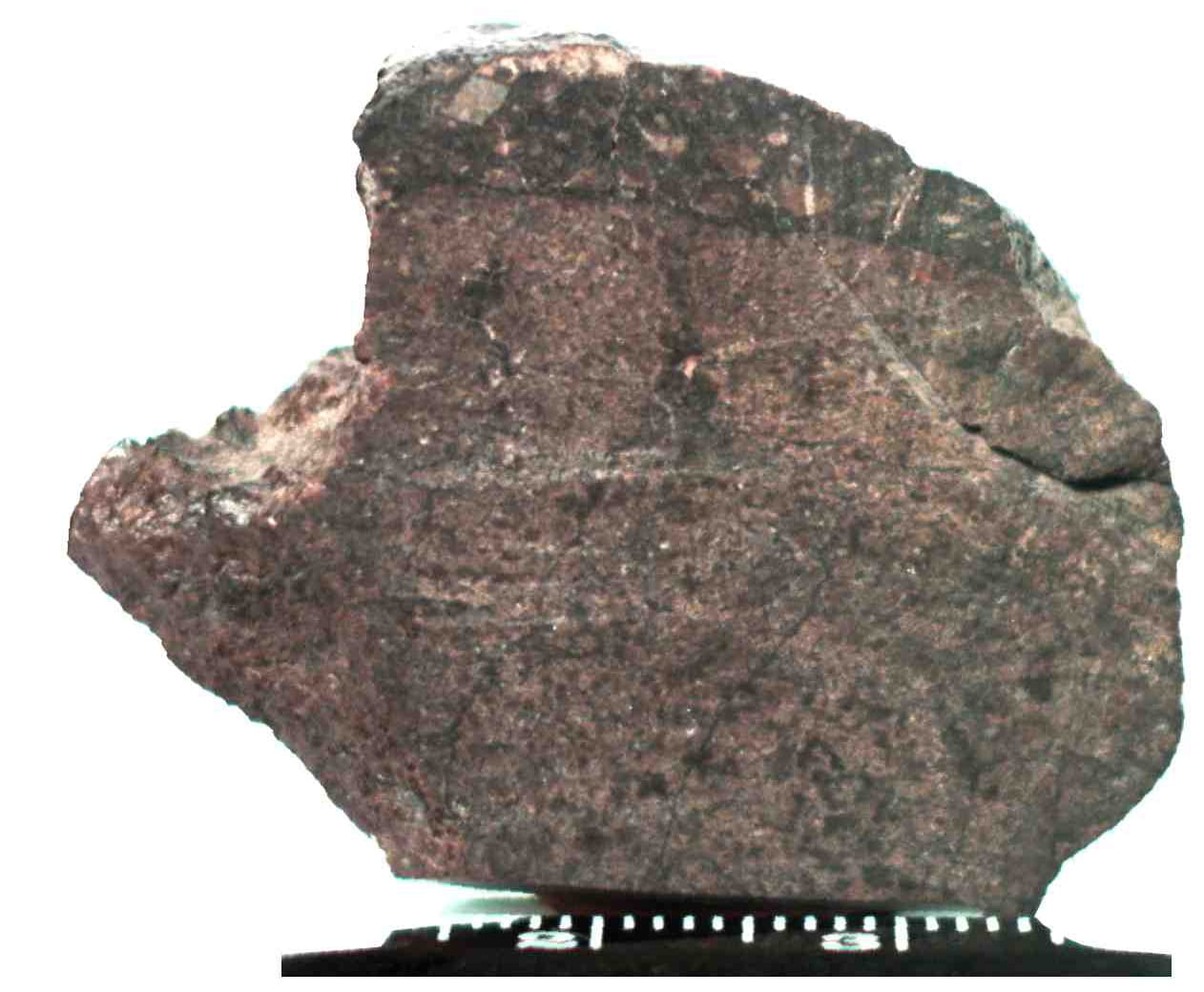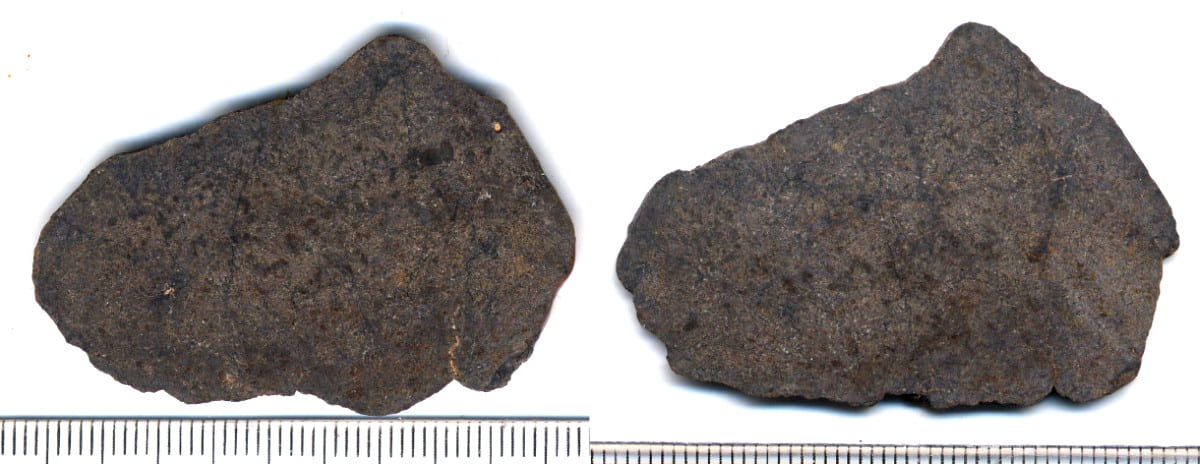Lunar Meteorite: Dhofar 287





|
from The Meteoritical Bulletin, No. 85 Dhofar 287Oman Lunar meteorite (Low-Ti, olivine-pyroxene mare basalt breccia) History: A dark gray, 154 g black stone without fusion crust was found in the Dhofar region of Oman, 400 m from Dhofar 025. Classification and mineralogy (M. Nazarov, Vernad; L. Taylor, UTenn): contains two adjacent lithologies, mare basalt (95 vol%) and regolith breccia (5 vol%). Basaltic portion: consists of olivine (Fo70-45) and minor augite (Wo30-40 En38-45) phenocrysts (up to 1 mm) set in a subophitic, fine-grained (50-100 µm) groundmass composed of plagioclase (An85-75) and pyroxene (Wo10-25En2-50), with accessory pyroxferroite, K-Ba feldspar, apatite, ilmenite, Ti-rich chromite, ulvöspinel, baddeleyite, silica, tranquillityite, troilite, Fe-Ni metal, and a fayalite + K-rich glass mesostasis; shock veins and impact melt pockets are present; plagioclase is totally converted to maskelynite; mineral modes (vol%) are pyroxene = 49, maskelynite = 26, olivine = 18, opaques = 4, impact melt = 2; whole-rock TiO2 content = 2.8 wt%; Fe/Mn = 75; a prominent negative Eu anomaly is present; similar in composition to Apollo 12 mare basalts, but distinctly higher in Na and incompatible elements. Regolith breccia portion: clast-rich, with numerous lithic and mineral grains (up to 1 mm) cemented by fine-grained mineral fragments (<100 µm) and minor impact melt; dominated by low-Ti and VLT mare basalt lithologies; minor highland material probably present; lithic clasts are fine- grained, vitrophyric, granular to ophitic, basaltic rocks and impact melt breccias; mineral fragments dominated by pyroxene, olivine, and plagioclase; glass fragments and spherules also occur; plagioclase, An98-66; olivine, Fo80-25; pyroxenes highly variable, Wo5-40En2-80; main accessories are silica, fayalite, pyroxferroite, K-rich glass, apatite, ilmenite, Ti-rich chromite, ulvöspinel, troilite, and FeNi metal. Specimens: 32 g and two thin sections, Vernad; main mass with anonymous finder. |
Randy Says… Dhofar 287 is not paired with any other lunar meteorite. To my knowledge, there is no chemical analysis of the regolith breccia. |
More InformationMeteoritical Bulletin DatabaseDhofar 287 MapSchematic Map of Find Locations of Lunar Meteorite from Oman ReferencesAnand M., Misra K., Taylor L. A., Nazarov M. A., Clayton R. N., and Mayeda T. K. (2002) Apparently KREEPy lunar meteorite Dhofar 287a: The residual melt tapped from a fractionating magma chamber. Lunar and Planetary Science XXXIII, abstract no. 1635. Anand M., Taylor L. A., Nazarov M. A., and Patchen A. (2003) Petrologic comparisons of lunar mare basalt meteorites Dh-287A and NWA 032. Lunar and Planetary Science IIIIV, abstract no.1787. Anand M., Taylor L. A., Misra K. C., Demidova S. I., and Nazarov M. A. (2003) KREEPy lunar meteorite Dhofar 287A: A new lunar mare basalt. Meteoritics & Planetary Science 38, 485-499. Calzada-Diaz A., Joy K. H., Crawford I. A., and Nordheim T. A. (2015) Constraining the source regions of lunar meteorites using orbital geochemical data. Meteoritics & Planetary Science 50, 214-228. Connelly J. N., Nemchin A .A., Merle R. E., Snape J. F., Whitehouse M. J., and Bizzarro M. (2022) Calibrating volatile loss from the Moon using the U-Pb system. Geochimica et Cosmochimica Acta 324, 1-16. Day J. M. D. and Paquet M. (2020) Highly siderophile element abundances in mare basalts reflect late accretion to the Moon’s interior. 51st Lunar and Planetary Science Conference, abstract no. 1071. Demidova S., Nazarov M. A., Anand M., and Taylor L. A. (2002) Clast population of lunar regolith breccia Dhofar 287B. Lunar and Planetary Science 33, abstract no. 1290. Demidova S. I., Nazarov M. A., Anand M., and Taylor L. A. (2003) Lunar regolith breccia Dhofar 287B: A record of lunar volcanism. Meteoritics & Planetary Science 38, 501-514. Fernandes V., Becker T., Renne P., and Burgess R. (2008) Preliminary Ar-Ar studies of lunar basaltic meteorite Dhofar 287-A. Geochimica et Cosmochimica Acta 72, A264. Text Fernandes V. A. S. M., Fritz J. P., Wünnemann K., and Hornemann U. (2010) K-Ar ages and shock effects in lunar meteorites. EPSC Abstracts, Vol. 5, EPSC2010-237. Korotev R. L. (2005) Lunar geochemistry as told by lunar meteorites. Chemie der Erde 65, 297-346. Korotev R. L. (2011) Lunar meteorites from Antarctica and Oman. 74th Annual Meeting of the Meteoritical Society, abstract no. 5073. Korotev R. L. (2012) Lunar meteorites from Oman. Meteoritics & Planetary Science 47, 1365-1402. Korotev R. L. (2017) Update (2012–2017) on lunar meteorites from Oman. Meteoritics & Planetary Science 52, 1251-1256. All Korotev data on Omani lunar meteorites. Korotev R. L. and Zeigler R. A. (2007) Keeping up with the lunar meteorites. Lunar and Planetary Science XXXVIII, abstract no. 1340. Korotev R. L., Irving A. J., and Bunch T. E. (2008) Keeping up with the lunar meteorites – 2008. Lunar and Planetary Science XXXIX, abstract no. 1209, 39th Lunar and Planetary Science Conference. Nazarov M. A., Badyukov D. D., Lorents K.A., Demidova. S. I. (2004) The flux of lunar meteorites onto the Earth. Solar System Research 38, 49-58. Rochette P., Gattacceca J., Ivanov A. V., Nazarov M. A., and Bezaeva N. S. (2010) Magnetic properties of lunar materials: Meteorites, Luna and Apollo returned samples. Earth and Planetary Science Letters 292, 383-391. Schiller M., Bizzarro M., and Fernandes V. A. (2018) Isotopic evolution of the protoplanetary disk and the building blocks of Earth and the Moon. Nature 555, 507-510. Shih C.-Y., Nyquist L. E., Reese Y., Wiesmann H., Nazarov M.A., and Taylor L.A. (2002) The chronology and petrogenesis of the mare basalt clast from lunar meteorite Dhofar 287: Rb-Sr and Sm-Nd isotopic studies. Lunar and Planetary Science XXXIII, abstract no. 1344. Taylor L. A., Nazarov M. A., Demidova S. I., and Patchen A. (2001) Dhofar 287: A new lunar mare basalt from Oman. 64th Annual Meteoritical Society Meeting, abstract no. 5106. Terada K., Sasaki Y., Anand M., Sano Y., Taylor L. A., and Horie K. (2008) Uranium-lead systematics of low-Ti basaltic meteorite Dhofar 287A: Affinity to Apollo 15 green glasses. Earth and Planetary Science Letters 270, 119-124. |